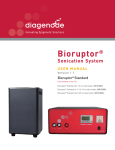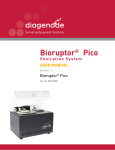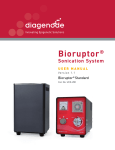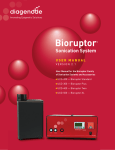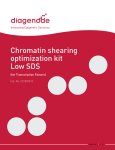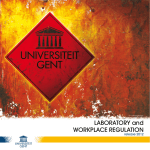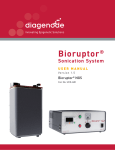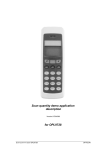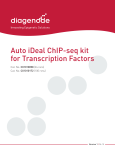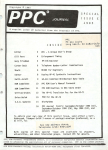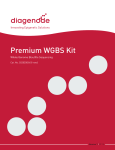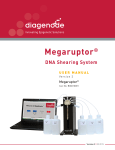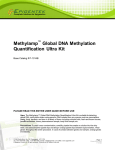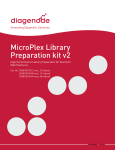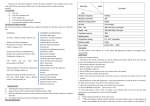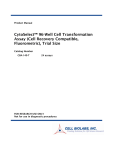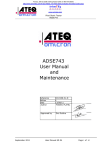Download - Diagenode
Transcript
USER MANUAL Bioruptor® Plus Soni ca t i o n Sy s t e m Cat. No. B01020001 Version 1.2 I 04.15 PAGE 2 DIAGENODE BIORUPTOR® PLUS USER MANUAL Guarantee Limited one year global warranty Diagenode guarantees all products from any manufacturing defects as we rigorously test all products to meet strict quality standards. Diagenode warrants that all standard components of its instruments will be free of defects in materials and workmanship for a period of one (1) year from the date that the warranty period begins, unless the original quotation or accompanying documentation states a different warranty period. All warranty periods begin on the date of delivery and apply only to the first purchaser of the product. If a manufacturing defect arises and a valid claim is received within the warranty period, Diagenode, at its discretion, will repair or replace the product in accordance with the warranty terms and conditions stated herein. In case of repair or replacement of a product under warranty, Diagenode will cover the expenses to return the repaired or replacement product. This warranty covers only manufacturing defects and does not cover any damage caused by misuse, lack of compliance to recommendations stated in the manual, neglect, accidents, abrasion, or exposure to extreme temperatures, chemical solvents, or acids. We strongly recommend that maintenance or repairs of Diagenode’s products are performed by our approved Diagenode service center. Improper or incorrectly performed maintenance or repairs will void the warranty. Technical Assistance & Ordering Information Diagenode s.a. BELGIUM | EUROPE Diagenode Inc. USA | NORTH AMERICA LIEGE SCIENCE PARK 400 Morris Avenue, Suite #101 Rue Bois Saint-Jean, 3 Denville, NJ 07834 - USA 4102 Seraing (Ougrée) - Belgium Tel: +1 862 209-4680 Tel: +32 4 364 20 50 Fax: +1 862 209-4681 Fax: +32 4 364 20 51 [email protected] [email protected] [email protected] [email protected] For a complete listing of Diagenode’s international distributors, visit: http://www.diagenode.com/en/support/distributors.php For the rest of the world, please contact Diagenode s.a. Innovating Epigenetic Solutions DIAGENODE BIORUPTOR® PLUS USER MANUAL Contents Critical Steps for Maintenance and Efficient Shearing . . . . . . . . . . . . . . . . . . . . . . . . . . . . . . . . . . . . . 4 Introduction. . . . . . . . . . . . . . . . . . . . . . . . . . . . . . . . . . . . . . . . . . . . . . . . . . . . . . . . . . . . . . . . . . . . . . . . . . 5 Bioruptor ® Technical Specifications . . . . . . . . . . . . . . . . . . . . . . . . . . . . . . . . . . . . . . . . . . . . . . . . . . . . . 6 Getting to Know Your Bioruptor ® System. . . . . . . . . . . . . . . . . . . . . . . . . . . . . . . . . . . . . . . . . . . . . . . . . 7 Bioruptor® Components Overview . . . . . . . . . . . . . . . . . . . . . . . . . . . . . . . . . . . . . . . . . . . . . . . . . . . . 7 Sonication bath. . . . . . . . . . . . . . . . . . . . . . . . . . . . . . . . . . . . . . . . . . . . . . . . . . . . . . . . . . . . . . . . . . . . 7 Motorized lid. . . . . . . . . . . . . . . . . . . . . . . . . . . . . . . . . . . . . . . . . . . . . . . . . . . . . . . . . . . . . . . . . . . . . . 8 Metallic soundproof box. . . . . . . . . . . . . . . . . . . . . . . . . . . . . . . . . . . . . . . . . . . . . . . . . . . . . . . . . . . . .9 Tube holders. . . . . . . . . . . . . . . . . . . . . . . . . . . . . . . . . . . . . . . . . . . . . . . . . . . . . . . . . . . . . . . . . . . . . . 9 Equipment Installation . . . . . . . . . . . . . . . . . . . . . . . . . . . . . . . . . . . . . . . . . . . . . . . . . . . . . . . . . . . . . . . 10 Installation overview . . . . . . . . . . . . . . . . . . . . . . . . . . . . . . . . . . . . . . . . . . . . . . . . . . . . . . . . . . . . . . 10 Installing the Bioruptor® System . . . . . . . . . . . . . . . . . . . . . . . . . . . . . . . . . . . . . . . . . . . . . . . . . . . . 12 Controlling the Sonication. . . . . . . . . . . . . . . . . . . . . . . . . . . . . . . . . . . . . . . . . . . . . . . . . . . . . . . . . . . . . 13 Using Tube Holders . . . . . . . . . . . . . . . . . . . . . . . . . . . . . . . . . . . . . . . . . . . . . . . . . . . . . . . . . . . . . . . . . . 15 Standard protocols. . . . . . . . . . . . . . . . . . . . . . . . . . . . . . . . . . . . . . . . . . . . . . . . . . . . . . . . . . . . . . . . . . . 16 DNA Shearing. . . . . . . . . . . . . . . . . . . . . . . . . . . . . . . . . . . . . . . . . . . . . . . . . . . . . . . . . . . . . . . . . . . . 16 Chromatin Shearing. . . . . . . . . . . . . . . . . . . . . . . . . . . . . . . . . . . . . . . . . . . . . . . . . . . . . . . . . . . . . . . 19 Bacteria Cell Disruption . . . . . . . . . . . . . . . . . . . . . . . . . . . . . . . . . . . . . . . . . . . . . . . . . . . . . . . . . . . 21 Troubleshooting. . . . . . . . . . . . . . . . . . . . . . . . . . . . . . . . . . . . . . . . . . . . . . . . . . . . . . . . . . . . . . . . . . . . . 23 Related Products. . . . . . . . . . . . . . . . . . . . . . . . . . . . . . . . . . . . . . . . . . . . . . . . . . . . . . . . . . . . . . . . . . . . 24 Ordering Information. . . . . . . . . . . . . . . . . . . . . . . . . . . . . . . . . . . . . . . . . . . . . . . . . . . . . . . . . Back Cover www.diagenode.com | PAGE 3 PAGE 4 DIAGENODE BIORUPTOR® PLUS USER MANUAL Critical Steps for Maintenance and Efficient Shearing General warnings Bior upto r • DO NOT turn on the instrument without water. •DO NOT tilt the sonication bath. To change the water, use either the plastic pump or a beaker. Water level (sonication bath) •The sonication bath must be filled with distilled water only to the fill line (do not use deionized water). Fill line replacement stickers can be obtained by contacting Diagenode. Change water at least once per week. Water temperature (sonication bath) •Optimal water temperature for sonication is 4°C. Sample temperature should not exceed 10°C. •Methods to maintain the temperature. - Ice - add small amounts of crushed ice (no more than 0.5 cm) to the bath every 10 min. - Water Cooler (Cat. No. B02010002, 230 V and B02010003, 115 V) - in combination with continuous valve (flow rate of the circulating water cannot exceed 500 ml per minute for optimal sonication). In combination with regulating valve (Single Cycle Valve; Cat. No. B02020004) the water will be only replaced during the Off cycle to avoid any interference between the water flow and the sonication process. Magnetic Ultrasound Emitter Maintenance •The ultrasound waves are created from a series of magnets that are attached to the water tank. This system is very sensitive to the heat generated during a run. •Do not exceed 30 minutes (it can be increased to 45 minutes using low power) of total sonication per run. It is critical that the machine allowed to cool at least 15 minutes between runs. Damage resulting from non compliance to manual instructions will void the warranty and shorten the lifespan of the machine. •Ultrasound Emitters can be damaged by tilting or jarring the machine. Exercise care if moving water tank. Validated tubes for the Bioruptor® Plus • DNA shearing: 0.5 ml Bioruptor® Microtubes (Cat. No. C30010013). •Chromatin Shearing: 1.5 ml TPX Microtubes (Cat. No. C30010010) and 15 ml TPX tubes (Cat. No. C30010009). Others tubes might be used but will require additional optimization. Once a brand of tube is optimized, switching brands may result in changes in sonication efficiency. Fitting 0.5 ml or 1.5 ml tubes in the corresponding tube holder 1.Place the tubes on the corresponding tube holder (0.5 ml tube holder - Cat. No. B01200043 or 1.5 ml tube holder Cat. No. B01200011). Never leave empty spaces in the tube holder. Fill the empty spaces with tubes containing the same volume of water. Screw the lid on the tube holder without over-tightening the lid. 2.Carefully place the tube holder on the holding plate. 3.During sonication, samples must remain at the bottom of the tube. If needed, briefly centrifuge samples during sonication after pausing the run. Innovating Epigenetic Solutions DIAGENODE BIORUPTOR® PLUS USER MANUAL Fitting of 15 or 50 ml tubes in the corresponding tube holder 1. Loosen both the blue and the black top prior to placing the metallic reflecting bar in the tube. 2.First tighten the blue ring then the black top. This will ensure the O-ring is properly placed in the tube. Introduction Diagenode’s Bioruptor® Plus uses a gentle method of sonication to retain the integrity of DNA and/or biological complexes, including chromatin, protein-protein binding, protein-DNA complexes and other biochemical and biological assay systems. The Bioruptor® Sonication System uses a sonication bath to generate indirect sonication waves, which emanate from an ultrasound element below the water tank. Because the system is gentler than other sonicators, the Bioruptor® produces better and more consistent results than with harsher sonication methods. Up to 12 closed tubes can be sonicated in parallel and the continuous rotation of tubes allows even distribution of the energy for efficient sonication. The Bioruptor® enables automation of sonication, guaranteeing higher reproducibility of results. Ultrasound Transducer Fig 1. Propagation in 0.5 ml tubes and 1.5 ml tubes The effect of ultrasound on biological samples The Bioruptor® sonication system uses ultrasound to create focused mechanical stress to lyse cells or shear DNA or chromatin. Ultrasound waves pass through the sample expanding and contracting the liquid. During expansion, negative pressures pull the molecules away from one another to form a cavity or bubble. This process is called cavitation. The bubble continues to absorb energy until it can no longer sustain itself and implodes. This produces intense focused shearing forces, that disperse and break biomolecules. The fragmentation of DNA takes place as a consequence of this mechanical stress or shear. Ultrasound Transducer Fig 2. Propagation in 15 ml & 50 ml tubes With the Bioruptor®, the entire volume of water present in the sonication bath is exposed to ultrasound, allowing all the samples to be efficiently sonicated (Figure 1). For larger tubes (15 ml or 50 ml), the transfer of the ultrasound to the tubes is facilitated by a metallic bar in contact with the sample. This metallic bar is not a probe (no corrosion problems) but “reflects” the ultrasound originated from the sonication bath and improves the sample sonication efficiency by a patented resonance system (Figure 2). Noise level measurements & precautions CEE noise data is not applicable to the Bioruptor’s ultrasound emitter as no tests have been conducted on similar devices to date. See listed noise levels (as measured in the Accredited Acoustics Laboratory) and precautions for the Bioruptor®: Leq = noise level in dBA = 78.4 dB Lmax = dB Peak = 87.6 dB 1. Exposure limit value The exposure limit value is the maximum amount of noise an employee may be exposed to on any single day (8 hours). Exposure beyond this limit presents a high risk to the user. LEXPOSURE, 8h = 87 dB(A) PPEAK = 200 Pa (140 dB(C) referring to 20 μPa) www.diagenode.com | PAGE 5 PAGE 6 DIAGENODE BIORUPTOR® PLUS USER MANUAL 2. Upper exposure Action value The exposure action value is the upper daily limit of noise exposure. Exposure beyond this value requires employers to take action to limit user exposure. LEXPOSURE, 8h = 85 dB(A) PPEAK = 140 Pa (137 dB(C) referring to 20 μPa) 3. Lower exposure action value LEXPOSURE, 8h = 80 dB(A) PPEAK = 112 Pa (135 dB(C) referring to 20 μPa) Use of Bioruptor® by pregnant women Exposure to 20-60 kHz sound waves has not been shown to be harmful to human health. However, we would recommend avoiding unnecessary exposure. Diagenode recommends that pregnant women should not be exposed to 20-60 kHz wave lengths for a long period of time. Bioruptor® Technical Specifications Bioruptor® Power Supply 100 - 240 Vac Control unit dimensions 350(W) x 260(D) x 165(H) mm Sonication unit dimensions (sonication bath) 175(W) x 160(D) x 265(H) mm Soundproof box dimensions 350(W) x 350(D) x 500(H) mm Sonication bath volume 750 ml Timer Digital Possibility to control water flow via connector kit for water cooler Interval Timer Yes 0-60 sec. or min. (on/off cycles) Total Weight 30 Kg Tube holder Available for 0.5 - 1.5 - 10 - 15 & 50 ml tubes Number of samples to be processed simultaneously Innovating Epigenetic Solutions 0.5 ml tubes – 12 1.5 ml tubes - 6 10 ml tubes - 6 15 ml tubes - 6 50 ml tubes - 3 DIAGENODE BIORUPTOR® PLUS USER MANUAL Getting to Know Your Bioruptor® Plus System Bioruptor® Components Overview Control Unit Sonication bath Power Cable Control Unit Cable Motorized lid Soundproof Box Tube holder example Sonication bath The sonication bath is a critical component of the instrument. The generators below the tank produce ultrasonic waves which are then transferred through water. The sonication bath requires special handling and care as described below. Handling The sonication bath must remain upright at all times, especially when moved. Tilting the sonication bath or handling roughly may damage the ultrasound emitter component, resulting in a substantial drop in sonication efficiency. If transportation of the apparatus is required after initial set-up, it is imperative to keep the tank at a right angle to the ground during the transport at all times. Water level and quality The level of the water has been optimized and should always reach the red line (sticker on the wall of the tank). Use only distilled water to fill the tank. Do not use deionized water. Replacement stickers can be obtained from Diagenode. Water temperature The water in the sonication bath must be kept at 4°C. Ultrasonic waves produced by the Bioruptor® generate heat. Drop off in efficiency will occur above 10°C. To ensure preservation of the samples and to prevent damage to the instrument, it is necessary to start the sonication process with cold water and to keep it at 4°C during the sonication process. www.diagenode.com | PAGE 7 PAGE 8 DIAGENODE BIORUPTOR® PLUS USER MANUAL Manual temperature control •A “precooling” of the Bioruptor®’s tank 15 min before starting the first round of sonication is advised. This prevents the water from heating too quickly due to thermal inertia (i.e. when the tank and the ultrasound generating elements are stored at room temperature). To precool, simply add crushed ice and then fill with cold water up to the indicated level (red line on the water level sticker). •Every 10 min replace crushed ice. The ice floating in the water should not exceed 0.5 cm and the total water level (water & ice) should be exactly at the indicated water level. - Fill entirely a 250 ml beaker with crushed ice - Pour ice carefully into your sonication bath (which is already filled with to the red fill line) - Remove approximately 130 ml of water (without ice) - Carefully adjust water level to the indicated mark (red line) by removing or adding water using a pipette Automatic temperature control The Water Cooler (Cat. No. B02010002, 230 V and B02010003, 115 V) can be used in combination with the Standard Connector Kit (continuous valve) to guarantee the automatic temperature control of the sonication bath during the entire sonication process. The water flow shouldn’t exceed 500 ml/min to allow optimal resonance. The Water Cooler features two pumps and produces a regular water flow to maintain a constant water level in the tank. An additional regulating valve (Connectors Kit for Water Cooler; Cat. No. VB-100-0001) ensures that the water will only be replaced during the off cycle to avoid any interference between water flow and the sonication process. Single Cycle Valve Water Cooler Sonication Bath Control unit Fig. Setup of the Bioruptor® Plus in combination with the Water Cooler. Note: You may permanently install the Bioruptor® in a cold room, though this is not sufficient to avoid the temperature increase during sonication. The cold room would only eliminate the need for the “precooling” step described above. Motorized Lid The motorized lid, along with the blue gear plate accessory, keeps the sample tubes in constant rotation and ensures optimal position in the sonication bath during sonication. When in motion, do not hamper the rotation of the blue gear plate. Avoid the immersion of the motor into the water. Do not heat the blue plastic as it will warp. Innovating Epigenetic Solutions DIAGENODE BIORUPTOR® PLUS USER MANUAL Metallic Soundproof Box This metallic soundproof box absorbs more than 30 dBA generated by the ultrasonic sonication bath (Figure 4). Sound pressure level (dBA) 79 dBA 100 80 46 dBA 60 40 20 0 Soundproof Box Bioruptor® without soundproof box Bioruptor® with soundproof box Fig. Sound pressure of the Bioruptor® without and with metallic soundproof box has been measured in a soundproof room. Tube Holders Several sizes of tubes can be used with the Bioruptor® Plus. The minimum and maximum sample volume to be used with each container is given in the table below. The 0.5 ml and 1.5 ml tubes can be simply closed and installed in the rotor. For the sonication of larger volumes (10 ml, 15 ml and 50 ml tubes), a stopper with a metallic bar has to be used to reflect sound waves to produce a better resonance efficiency. Tube Size Tube Holders Minimum Maximum 0.5 ml 50 µl 100 µl 1.5 ml 100 µl 300 µl 10 ml 500 µl 2 ml 15 ml 500 µl 2 ml 50 ml 3 ml 20 ml www.diagenode.com | PAGE 9 PAGE 10 DIAGENODE BIORUPTOR® PLUS USER MANUAL Equipment Installation The following pages contain information on installing your Bioruptor® Plus model. This equipment must only be installed by personnel after reading this section. Consider all hazards even though no particular hazards have been identified during installation. Before starting installation work, turn the main switch off (back side of the control unit) and secure the unit against being re-energized. No special tools are required. Three (3) square meters are needed to set-up the Bioruptor®. Devices are designed to be safe under the following conditions: •Indoor use •Power plug must be grounded •Altitude up to 2,000 meters •POLLUTION DEGREE 2 (Normally only non-conductive pollution occurs. However, occasionally a temporary conductivity caused by condensation is expected) •Operating external temperature 0°C to 25°C •Maximum relative humidity 80% •Transient overvoltage typically present on the MAINS supply •Never install this equipment in a place where environmental conditions and warnings mentioned above are infringed •Degree of protection: IP20 Installation overview Level meter Digital timer 3 Power button Start Low / high Stop Metallic soundproof box 1 0.5 & 1.5 ml tube adaptor 10 ml, 15 ml tube adaptor Motorized lid 2 50 ml tube adaptor Single cycle valve Water Water bath BIORUPTOR PLUS 4 ® 5 Power cord Fig. Schematic installation overview of the Bioruptor® Plus System in combination with the Bioruptor® Water Cooler. Innovating Epigenetic Solutions WATER COOLER DIAGENODE BIORUPTOR® PLUS USER MANUAL 1 Flexible format Fits into current workflow with standard tubes. Scales with flexible sample volume. 2 Rotation Prevents contamination with closed tubes. Continuous rotation through sonication bath guarantees equal distribution of energy. 3 Flexible control Easy to program. Power range effectively disrupts samples. 4 Gentle ultrasound Gentle ultrasound method preserves sample. 5 Cooling Cooling system maintains integrity of sensitive samples. Attaching Cables The power supply adapter must be plugged into the power grid. An IEC lead is provided. IMPORTANT WARNING: Ensure that your power inlet (behind the power supply adapter) shows the right voltage corresponding to your area. Otherwise, switch it using a narrow blade screwdriver. When connecting cables, always be sure pins are properly aligned. Note the indexing pins on the control unit cables for precise mating alignment. Keep dot facing up. Once plugged in, secure by turning 90° clockwise until a click is heard. www.diagenode.com | PAGE 11 PAGE 12 DIAGENODE BIORUPTOR® PLUS USER MANUAL Installing the Bioruptor® Plus System 1. Open the boxes and unpack all components 2. Place sonication bath in 3.Remove the rubber cap (upper left hole marked machine cable) from the back of the front of the soundproof box soundproof box and feed the control unit cable through the hole. The fitting will secure the cable to the sound-proof box. Turn the front section counterclockwise to seal. Be sure there is enough slack in the cable 4.Plug the control unit cable into the sonication bath 5.Place the motor lid on the top of the sonication bath and 6.Place the sonication bath connect it. Make sure that the cable of the motor lid is into the soundproof box connected as shown in the image (triangles have to match) 8. Place the control unit on the top of the soundproof box. Plug the power cable into the outlet and switch on the power switch on the back of the control unit 7.Fill the sonication bath up to the red fill line with distilled water 9. If available, place the Water cooler below the Bioruptor. The minimum elevation difference should be 400 mm or 15,74 inch. Now you are ready to start! Innovating Epigenetic Solutions DIAGENODE BIORUPTOR® PLUS USER MANUAL Controlling the Sonication Digital Timer: Allows the user to easily program the sonication of samples (ON/OFF pulse time & total time). See use of digital timer in next section below Stop Button: Ends sonication Intensity Setting Button: Adjusts intensity of the ultrasonic waves generated Intensity Level Meter: Indicates the sonication intensity Start Button: Begins sonication Power Switch: Turns Bioruptor on and off CYCLE NUMBER, TIME ON and TIME OFF and SONICATION INTENSITY are the parameters controlling the sonication. First press + or - depending on the value to be modified. The five flashing black squares move up or down. Once you have selected the parameter to be modified, press OK again. The five flashing black squares disappear and 2 digits start flashing. The digits can be changed by pressing + or -. To select and save the correct number, press OK to confirm or ESC to escape without saving the change. IMPORTANT NOTE: Minimum time of the off cycle: 30 seconds. Digital Timer After the introductory message, the control screen shows the main sonication parameters in the first three lines (CYCLE Number, Time ON, Time OFF) and summary of actions in the last line (see example below). CYCLE Num : 10 Time ON : 30sec Time OFF : 30sec Press OK = Modify BIORUPTOR RUNNING ***************** CYCLE Num : 04/10 ON Bath 1 OFF TIME ON TIME OFF Cycle number reached (4 cycles in this example) CYCLE START The display shows cycle 4 of 10. Bioruptor® NGS will sonicate as shown. Buttons and their functions Button A: Pause / restart after pausing Button B: Press and hold this button during sonication to display T1 (total on time per cycle) and T2 (total off time per cycle). ESC: Cancels previous selection OK: Validate selection - : Decrease selected parameter/move down + : Increase selected parameter/move up Once all parameters are selected and confirmed, press START. Once the run is started, “BIORUPTOR RUNNING” is displayed on the control screen. www.diagenode.com | PAGE 13 PAGE 14 DIAGENODE BIORUPTOR® PLUS USER MANUAL Overheat Shutdown The ultrasound source is sensitive to high temperatures which means that increases in temperature diminish the sonication efficiency and can damage the device. The production of ultrasound generates heat which is transferred into the sonication bath. To avoid excessive overheating of the ultrasound source, the Bioruptor® Plus (UCD-300) contains a temperature sensor. We recommend that the water in the sonication bath remains between 4˚C–10˚C (39°F—50°F) for optimum sonication. Note: The sensor does not measure the water temperature inside the ultrasound bath where the samples are submerged. Once a critical limit is reached a warning is displayed on the control screen. Depending on the situation, different screens pop up as described below: 1. If START is pressed and the instrument stops after a couple of seconds showing the following screen blinking, the instrument could not start a new run due to the ultrasound source’s temperature. Machine too hot to start a new run See Manual Causes: • Instrument has been used several times in a row recently without breaks • Instrument is stored in a place exposed to direct sun • Room temperature is too hot What to do: • Store the instrument in another place if the current one does not meet the installation specific requirements • Allow for longer breaks between uses • Place crushed ice in sonication bath to help the cool ultrasound source 2. During a run, if the instrument stops and the following screen pops up, the critical temperature has been reached. To protect the ultrasound source from damage, the instrument has stopped and is standing by to be restarted after the ultrasound source has cooled. RISK OF DAMAGE Machine stoped at Cycls XX/XX See Manual Causes: • Instrument has been running too long without breaks What to do: • Store the instrument in another place if the current one does not meet the installation specific requirements • Allow for longer breaks between uses • Place crushed ice in sonication bath to help to cool down the ultrasound source 3. If the warning message appears at the bottom of the BIORUPTOR RUNNING screen (see below), it means that the critical temperature is about to be reached. BIORUPTOR RUNNING ***************** CYCLE Num : xx/xx WARNING gets hot Innovating Epigenetic Solutions Causes: • Instrument has been running too long without breaks What to do: • Reduce the number of consecutive cycles or split protocols into two runs separated by a break • Keep cold water in the sonication bath while running to help keep the ultrasound source at low temperature DIAGENODE BIORUPTOR® PLUS USER MANUAL Tube holders & tubes Tube holders - Available for 0.5 ml, 1.5 ml, 10 ml, 15 ml, and 50 ml To use adaptor tube unit, remove the lower part of the microtube holder by turning counterclockwise. Then place microtubes in the unit. Attach the lower part to the upper part of the adaptor. To guarantee homogeneity of chromatin shearing, the tube holders should always be completely filled with tubes. To ensure reproducibility, always use the same brand of tubes. • The 2 ml polypropylene tubes (thin-walled) should not be used with the Bioruptor®. 1.5 ml tubes in TPX plastic that provide better ultrasound transfer rates and more efficient sonication are available from Diagenode (see price list). These tubes should be used for chromatin shearing, not DNA shearing. • Any 0.5 ml or 1.5 ml tube can be used although shearing efficiency is increased by using the hard plastic tubes (TPX hard plastic) available from Diagenode. See catalog numbers on price list. • For DNA shearing only 0.5 ml Bioruptor® Microtubes (Cat. No. C30010013) can be used. • The complete adaptor (including O-ring) can be sterilized in the autoclave. After more than 20 autoclave sterilizations, the O-ring might need to be replaced (see price list for spare parts). 0.5 ml tube holder (Cat. No. B01200043) 1.5 ml tube holder (Cat. No. B01200011) 10 ml tube holder (Cat. No. B01200012) 15 ml tube holder (Cat. No. B01200013) The tube holders for 15 ml tubes are available for Falcon & Corning tubes. If you use another brand of tubes, use the one which fits in the holder the best. When using the 15 ml tubes, do not forget to insert the aluminium ring to ensure an optimal position of the tube during sonication. 50 ml tube holder (Cat. No. B01200014) The tube holders for 50 ml tubes are available for Falcon tubes (blue) and for Corning tubes (orange). If you use another brand of tubes, use the one which fits in the holder the best. Note: The quality of the 50 ml Corning tube: “hard” plastic (Polyethylene, ref Corning 430304) can be used as well as “soft” plastic (Polypropylene, ref. Corning 430290 ) but you should stick to one kind as transfer of ultrasonic waves is different for the different tube types (hard plastic is more efficient). www.diagenode.com | PAGE 15 PAGE 16 DIAGENODE BIORUPTOR® PLUS USER MANUAL Holding Plates (included with any tube holder) The holding plate for 10 ml and 15 ml tubes can accommodate up to 6 tubes. For 50 ml tubes, the sample holding plate can accommodate up to 3 tubes. The holding plates should always be completely filled to guarantee homogeneity of shearing. O rings (for 10 ml, 15 ml, 50 ml tube holders) By removing the black knob, it is possible to replace the O-ring. The complete tube holder chip (including O-ring) can be sterilized in the autoclave. After more than 20 autoclave sterilizations the O-ring might need to be replaced (visit www.diagenode.com). Standard protocols DNA shearing For DNA shearing we highly recommend to use the tube holder for 0.5/0.65 ml tubes (Cat. No. B01200043) and the corresponding Bioruptor® 0.5 ml Microtubes for DNA Shearing (Cat. No. C30010013). 0.5 ml tube holder (Cat. No. B01200043) Bioruptor® 0.5 ml Microtubes for DNA Shearing (Cat. No. C30010013) To use the tube holder, remove the lower part by turning counterclockwise. Then place microtubes into the unit. Attach the lower part to the upper part of the adaptor. To guarantee homogeneity of DNA shearing, the tube holders should always be completely filled with tubes. Never leave empty spaces in the tube holder. Fill the empty spaces with tubes containing the same volume of distilled water. Operating conditions Sample volume: 100 µl Tubes: Bioruptor® 0.5 ml Microtubes for DNA Shearing (Cat. No. C30010013) Tube holder: 0.5 ml tube holder (Cat. No. B0120010) for 12 x 0.5 ml tubes Sonication buffer: TE (10 mM Tris, 1mM EDTA), pH 7.5 - 8.0 Innovating Epigenetic Solutions DIAGENODE BIORUPTOR® PLUS USER MANUAL DNA concentration:0.001-0.02 µg/µl (0.01 μg/μl recommended) Samples are vortexed (10-15 sec) and centrifuged (10 sec) before shearing. For optimal results samples should be stored on ice during 10-15 min prior to sonication. Temperature:Maintain at 4°C by using ice chilled water and small amounts of crushed ice (no more than 0,5 cm) or use the Water Cooler (Cat. No. B02010002, 230 V and B02010003, 115 V). Power setting: L position (Low) Sonication cycle and sonication time: varies depending on desired DNA size (see table) Note: Recommended protocols are subject to change without notice. Additional protocols are available on demand. Target size Cycle conditions (On/Off times in sec.) Number of cycles 1250 bp 15/90 2 cycles 950 bp 15/90 4 cycles 750 bp 30/90 3 cycles 550 bp 30/90 5 cycles 400 bp 30/90 6 cycles 350 bp 30/90 8 cycles 300 bp 30/90 10 cycles 250 bp 30/90 15 cycles 200 bp 30/90 30 cycles 150 bp 30/30 70 cycles The protocol settings listed above are recommended guidelines and actual results may vary depending on the type and amount of starting material, purity level, concentration and/or sample viscosity. It is highly recommended that a time course response experiment be carried out (e.g. varying the time of “On” and “Off” durations as well as the number of cycles) to determine the appropriate treatment for your specific sample. Starting material with a smaller sample volume and a greater concentration than the recommended range may require a different time course to ensure homogenous shearing results. www.diagenode.com | PAGE 17 PAGE 18 DIAGENODE BIORUPTOR® PLUS USER MANUAL Important comments about DNA shearing The Diagenode ACT (Adaptative Cavitation Transfer technology) process is highly reproducible, however attention must be paid to the following treatment attributes to ensure best results: •Tubes: At present, the recommended tube vessels are the Diagenode’s Bioruptor® 0.5 ml Microtubes for DNA Shearing (Cat No. C30010013). Pay attention not to damage the cap when closing the tubes since this could alter sonication results. •Sample volume: The recommended volume of the Diagenode’s Bioruptor® 0.5 ml Microtubes for DNA Shearing (Cat No. C30010013) is 100 μl. When using lower volumes (eg. ≤ 50 µl), less reproducible results may be observed due to an alteration of the ultrasonic waves distribution in the sample fluid; thus, reducing the efficiency of sonication which may result in broader size distribution or larger peaks. •Sample concentration: Diagenode recommends using a DNA concentration ranging between 1 and 20 ng/µl (10 ng/µl recommended). Using larger concentration (eg. 50-100 ng/µl) may result in broader peaks or variable peak distribution. •Sample preparation: Sample viscosity may have a major impact on sonication results. Careful resuspension of DNA sample is strongly recommended before sonication processing. Multiple pipetting and gentle vortexing followed by a short centrifugation to recover sample volume at the bottom of the tube is therefore strongly recommended. Storing DNA samples on ice during 10-15 min before sonication has also been shown to improve reproducibility. •DNA Qualtity: DNA quality and quantity must be considered carefully since bad quality and quantity DNA may have several impacts on sonication and next-gen sequencing downstream applications. First, DNA contamination (eg. from superfluous nucleic acids such as RNA, small nucleic acid fragments, excess proteins, or other contaminating materials) may interfere with DNA measurement method leading to incorrect DNA quantitation thus. Also contaminating RNA in genomic DNA preparation might generate a biased fragment distribution profile on microfluidics-based platform (eg. Agilent Bioanalyzer) or alter sonication effiency. Therefore it is highly recommended to use only high quality DNA when sonicating DNA for next-gen sequencing library preparation. The DNA sample to be processed should be highly pure, having an OD260/280 ratio of between 1.8 and 2.0, and should be as intact as possible. DNA extracted using standard techniques (eg. Proteinase K digested, double phenol/chloform extraction, ethanol precipitated, treatment with RNase-DNase free enzymatic digestion to remove contaminant RNA) or commercial spin-column based kits are recommended. •Water temperature: Propagation of ultrasound in a liquid unavoidably produces heat that can ultimately alter DNA sample (e.g. by thermal denaturation). To ensure the best preservation of the sample, it is recommended to start the sonication process with cold water in the sonication bath. During sonication, especially when doing long sonication runs, the temperature must also be controlled. Note: The permanent installation of the Bioruptor® in a cold room is possible, although not sufficient to avoid the temperature increase due to sonication. This location would only replace the “pre-cooling” step described above. •Automatic temperature control: A recirculating Water cooler is used to guarantee the automatic temperature control of the sonication bath during the whole sonication process. This Water cooler Cat No.B02010002, 230 V and B02010003, 115 V produces a regular water flow with a constant water level in the tank. •Sonication time: Minor adjustments in cycle number may be made to optimize results for various sample types and concentrations. The table above listing the cycle parameters and numbers is a recommended guideline. Actual results may vary depending on the amount and type of starting material, concentration, viscosity and/or plastic tubes. Diagenode recommends setting up a time dose response experiment for determining appropriate cycle number. Larger length starting material (e.g. total genomic DNA) and higher concentration may require a longer dose to ensure a homogeneous shearing result. Innovating Epigenetic Solutions DIAGENODE BIORUPTOR® PLUS USER MANUAL •Sonication bath: The sonication bath is a critical component of the Bioruptor® sonication system. 1. Water purity: Contaminants such as algae and particules may alter the ultrasonic waves propagation, resulting in broader size distribution or larger peaks. Bath water should be pure distilled water, changed regularly. 2. Sonication bath maintenance: The sonication bath metal surface is fragile and requires a careful maintenance. Use only soft sponge and distilled water to remove traces. Never use scratch scrub sponge since this would alter the ultrasonic wave emitter surface. Supplementary Data Please note that there are three main sources of variation in both peak base-pair size and distribution: 1)The physical process of DNA fragmentation might not be entirely random in AT- or GC- rich regions. 2)The analytical process to determine fragment size has inherent variances (for example, gel electrophoresis and microfluidics-based platform). Therefore, fragment distributions and peak values, even from technical replicates, may not appear identical. If the sheared DNA sample will be resin or column purified or concentrated prior to analysis, please remember to take out an aliquot for use as control prior to that step. Column purification and concentration of the sheared DNA will generate a biased fragment distribution profile due to the inherent greater loss of the smaller DNA fragments. 3)RNA contamination in genomic DNA preparation should be carefully removed using RNase-DNase free enzymatic digestion since they might generate a biased fragment distribution profile on microfluidics-based platform (eg Agilent Bioanalyzer) or alter sonication effiency. Chromatin shearing Critical points for chromatin shearing •Chromatin shearing efficiency varies on cell type. Each cell type might need additional protocol optimization. •The extent of cross-linking is critical for the efficient disruption of fixed cells and also affects DNA yield and average size of chromatin fragments. Over-cross-linked chromatin will not produce small fragments, even by prolonged sonication. Fix cells for 8-10 min at RT, always stop the reaction by glycine and wash 2-3 times with ice cold PBS. •Cell density affects the sonication efficiency. Do not use too dense cell suspension. Optimal density is about 1-3x10^6/100 µl of sonication buffer. •Fresh formaldehyde for fixation. Shearing of chromatin from adherent cell lines For the adherent cells, we recommend to first harvest cells by trypsinization and perform chromatin cross-linking in a cell suspension rather than on dishes as it results in a better reproducibility and consistency between experiments. 1.Discard medium to remove dead cells and wash cells by adding cold PBS 2.Harvest cells by trypsinization 3.Transfer cells in a tube containing 10 ml PBS (RT) and centrifuge 5 min at 1.300 rpm. Keep the cell pellet and discard the supernatant. Wash the cells again in PBS Note: At this step, cells might be counted. 4.Add PBS to a final volume of 500 μl for a maximum of 10x10^6 cells (for more cells, perform the fixation in a separate tube) www.diagenode.com | PAGE 19 PAGE 20 DIAGENODE BIORUPTOR® PLUS USER MANUAL 5. Add formaldehyde to a final concentration of 1%, mix gently and incubate for 8-10 min at RT with rotation 6.Stop the cross-linking reaction by adding glycine to a final concentration 0.125 M and incubate for 5 min at RT with rotation 7. Wash cells 3 times with cold PBS 8.Resuspend cells in an appropriate volume of a Lysis buffer containing SDS (0.7-1%). 1x10^6 -3x10^6 cells/300 µl are recommended for shearing in 1.5 ml tubes. Lyse cells on ice for 5-10 min. Vortex and centrifuge tubes before putting in Bioruptor® Note: Nuclei isolation is recommended when working with 3x10^6 cells to 10x10^6 cells. (Shearing ChIP kit from Diagenode is available for this purpose, kch-redmod-100). Diagenode 1.5 ml TPX Microtubes are recommended for efficient chromatin shearing (Cat. No. C30010010). 9.Sonicate samples with Bioruptor® Plus with refrigerated sonication bath (or crashed ice sonication bath) for 10-20-30 cycles of 30 sec ON and 30 sec OFF at HIGH setting. Briefly vortex and centrifuge tubes after each run of 10 cycles 10.Centrifuge samples at 14,000 rpm for 5 min at 4°C and transfer the supernatant into a new tube. Use an aliquot of sheared chromatin (equivalent of 100.000-500.000 cells) for analysis of shearing: perform a reversal of cross-links and analyze on agarose gel. The remaining chromatin might be kept at -80°C. Shearing of chromatin from suspension cell lines Note: Cells growing in suspension culture are known to be difficult to shear. Nuclei extraction is recommended before sonication. Do not use very dense cell suspension for sonication. 1. Cross-link chromatin with 1% fresh formaldehyde for 8-10 min at RT 2.Stop the cross-linking reaction by adding glycine to the final concentration 0.125 M for 5 min at RT with gentle rotation 3. Wash cells 3 times with cold PBS 4.Extract cell nuclei and use isolated nuclei for shearing (Shearing ChIP kit from Diagenode is available for this purpose, C010020020) 5.Resuspend nuclei in an appropriate volume of Lysis buffer containing SDS (1%). 1x10^6 – 3x10^6 cells/300 µl are recommended for shearing in 1.5 ml tubes. Lyse nuclei on ice for 5-10 min. Vortex and spin down tubes before putting in Bioruptor® Note: Diagenode 1.5 ml TPX Microtubes are recommended for efficient chromatin shearing (Cat. No. C30010010). 6.Sonicate samples with Bioruptor® Plus with refrigerated sonication bath (or crashed ice sonication bath) for 10-20-30 cycles of 30 sec ON and 30 sec OFF at HIGH setting. Briefly vortex and spin down tubes after each run of 10 cycles 7.Centrifuge samples at 14000 rpm for 5 min at 4°C and transfer the supernatant into a new tube. Centrifuge samples at 14,000 rpm for 5 min at 4°C and transfer the supernatant into a new tube. Use an aliquot of sheared chromatin (equivalent of 100.000-500.000 cells) for analysis of shearing: perform a reversal of cross-links and analyze in agarose gel. The remaining chromatin can be kept at -80°C. Innovating Epigenetic Solutions DIAGENODE BIORUPTOR® PLUS USER MANUAL Bacterial Cell Disruption For cell lysis, we highly recommend using 1.5 ml TPX Microtubes (Cat. No. C30010010) or 10 ml tubes (Cat. No. C30010012) and the corresponding tube holders (Cat. No. B01200043 and B01200012). To guarantee homogeneity of sonication, the tube holders should always be completely filled with tubes. Operating conditions: Tubes: 1.5 ml TPX Microtubes or 10 ml tubes Tube holder: 1 .5 ml tube holder (Cat. No. B01200043) or 10 ml tubes holder (Cat. No. B01200012) with reflecting bar Sample volume: 300 µl for 1.5 ml TPX Microtubes 2 ml for 10 ml tubes Sonication buffer: PBS with protease inhibitor cocktail Temperature: Maintain at 4°C by using the Water Cooler (Cat. No. B02010002, 230 V and B02010003, 115 V) or by using crushed ice Power setting: H position (High) Sonication cycle: 30 sec ON, 30 sec OFF Total sonication time: 10 min for Bioruptor® Standard ou Plus 15 min for Bioruptor XL (discontinued) Note: Please note that additional optimization might be required depending on the bacterial strain and growth phase. Gram-positive bacteria are more resistant to sonication than Gram-negative bacteria because of the rigid cell wall. Cells in log phase are less resistant than cells in stationary phase. In order to preserve protein structure and activity, avoid a long sonication. Protocol: 1. Collect cells by centrifugation at 1,000 g for 10 min at 4°C 2. Wash twice with cold PBS 3. Resuspend cells in cold PBS to OD600 3.0 4. Transfer cell suspension to sonication tubes. For optimal efficiency, use the recommended sample volume 5. Sonicate at High Power for 10 min (Bioruptor® Standard ou Plus) or 15 min (Bioruptor® XL) 6. Centrifuge at 15.000 rpm for 15 min at 4°C 7. Separate the soluble fraction (supernatant) from the insoluble (pellet) 8. The pellet can be used for extraction of insoluble proteins with a denaturating buffer of choice. www.diagenode.com | PAGE 21 PAGE 22 DIAGENODE BIORUPTOR® PLUS USER MANUAL Efficient cell disruption with Bioruptor® Cell suspensions were sonicated for different periods of time ranging from 5 to 20 min. Two types of tubes were tested: Diagenode’s 1.5 ml TPX Microtubes (Cat. No. C30010010) and Diagenode’s 10 ml Tubes (Cat. No. C30010012). The efficiency of cell disruption was initially determined by measuring optical density at 600 nm. The results indicated that the number of intact cells decreases rapidly with increasing sonication time. After only 5 min of sonication, a significant number of cells were disrupted (Fig.1). Similar results were observed using the Live/Dead BacLight kit (data not shown) which allows the quantification of live cells with intact membranes and discrimination from cells with damaged membranes. Thus, efficient cell disruption is observed after 5-10 min of sonication. Figure 1: Effect of sonication on cell disruption The number of intact cells after sonication was determined by measuring optical density at 600 nm. Optical density of the cell culture before sonication (0 min) is arbitrarily set to 100%. Sheared DNA is released during bacterial sonication The disruption of bacterial cells by sonication releases DNA with maximum recovery after only 5 min of treatment (Fig.A). The released DNA is fragmented with fragment size dependent on sonication time (Fig.B). A. B. M 0 min 5 min 10 min 15 min 20 min Figures : Effect of sonication on DNA release Figure A: The DNA concentration in each sample after sonication was quantified with the DNA BR assay kit (Invitrogen) Figure B: An aliquot of each sample before (0 min) and after sonication was run in a 1.5% agarose gel stained with SybrSafe and visualized in UV light. Lane M represents a 100 bp ladder. Innovating Epigenetic Solutions DIAGENODE BIORUPTOR® PLUS USER MANUAL Troubleshooting Bioruptor: Chromatin Shearing FAQs Critical Steps Questions Answers Comments What is the formaldehyde final concentration 1% Correct formaldehyde concentration in fixation is critical. How long is the fixation step? Fix for 10 min (with a time course when needed) It is possible to fix for as little as 5 min (depending on your protein of interest for subsequent ChIP assays). What is the temperature to use for fixation? Fix at room temperature Fixation can be performed at 4°C, RT, and 37°C. Make sure you perform the fixation step at the right temperature. Are the washes after fixation important? Wash the fixed cells properly. Make sure you get rid of ALL the formaldehyde. Use glycine to stop the fixation. Cell lysis How can I achieve complete cell disruption? Do not use too many cells in the cell lysis buffer. Lyse about 5x 10e6 cells/1 ml The HighCell # ChIP kit is compatible with cell numbers up to 10 million cells in small volumes. Number of cells/ shearing buffer volume What is the amount of cells per shearing trial to use? 1x 10e6–10x 10e6cells/ 300 µl 3x 106–30x 106 cells/ 1 ml Do not use a too high cell concentration. Shearing buffer What is the key buffer component? Include detergent in buffer Quality and quantity of detergent is important. How long is the shearing? Perform a time course for chromatin shearing It is possible to shear from 5-30 min. If 30’, interrupt sonication after every 10 min and centrifuge tubes briefly before proceeding with the remaining time. What is the optimal cycle? 30 seconds “ON” + 30 seconds “OFF” What is the best temperature for shearing? 4°C Make sure sonication bath is kept cool. Once optimal conditions are reached, use for all assays to assure reproducibility. What is the best volume/ tube for shearing? 1.5 ml per 15 ml tube 200 µl per 1.5 ml tube Do not use a too big sample volume What kind of gel should I use to determine size accuracy? Check disrupted material on a 1% agarose gel (10 µl/lane). Run the gel slowly Reverse cross-link from DNA after phenol/chloroform extraction before loading on gel. What do smears indicate? Gel electrophoresis of cross-linked samples often gives smears on gel. Also take several pictures of the gel to assure image quality. To obtain clearer image with accurate fragment size, reversion of the cross-linking is advised. How much DNA should I load and is RNAse treatment necessary? The migration of large quantities of DNA on agarose gel can lead to poor quality pictures which do not reflect the real DNA fragmentation. Do not load too much on a gel. Do not load more than 5 µg/lane. Also treat the sample with RNAse. What should my running buffer concentration be? 1X TAE or TBE is preferred to 0.5X TAE which can lead to smears on gel. Will using an old gel cause problems? Use a freshly prepared gel and fresh buffer. Fixation Shearing step Checking for high-quality shearing on an agarose gel Do not reuse an old gel. www.diagenode.com | PAGE 23 Ordering information Products Cat. No. (new) Bioruptor Models ® Bioruptor® Plus for 1.5 ml tube holder B01020001 Bioruptor® Plus for 1,5 & 15 ml tube holder B01020002 Bioruptor® Plus for 0.65 ml tube holder B01020003 Cooling System Water Cooler B02010002, 230 V - B02010003, 115 V Consumables 1.5 ml TPX Microtubes C30010010 15 TPX Tubes C30010009 0.5 ml Bioruptor® Microtubes C30010013v Connector Kits Single Cycle Valve for Water Cooler B02020004 Tube Holders 0.5 ml tube holder for Bioruptor® Standard, Bioruptor® Plus B01200043 1.5 ml tube holder for Bioruptor® Standard & Bioruptor® Plus B01200011 10 ml tube holder for Bioruptor® Standard & Bioruptor® Plus B01200012 15 ml tube holder for Bioruptor Standard & Bioruptor Plus B01200013 50 ml tube holder for Bioruptor Standard & Bioruptor Plus B01200014 ® ® ® ® Visit us at one of Diagenode’s demo sites or discover our Automated Systems by performing some assays with the help of our R&D and Technical Department. www.diagenode.com DIAGENODE HEADQUARTERS DIAGENODE S.A. BELGIUM | EUROPE DIAGENODE INC. USA | NORTH AMERICA LIEGE SCIENCE PARK Rue Bois Saint-Jean, 3 4102 Seraing - Belgium Tel: +32 4 364 20 50 Fax: +32 4 364 20 51 [email protected] [email protected] 400 Morris Avenue, Suite #101 Denville, NJ 07834 Tel: +1 862 209-4680 Fax: +1 862 209-4681 [email protected] [email protected] FOR A COMPLETE LISTING OF DIAGENODE’S INTERNATIONAL DISTRIBUTORS VISIT: http://www.diagenode.com/company/ distributors.php For rest of the world, please contact Diagenode sa. www.diagenode.com © 2015 Diagenode, Inc. All rights reserved. The content of this document cannot be reproduced without prior permission of the authors. Bioruptor & IP-Star are registered trademarks of Diagenode MA-BR-PLUS_V1.2-04_15
























